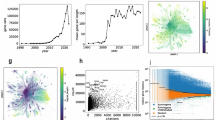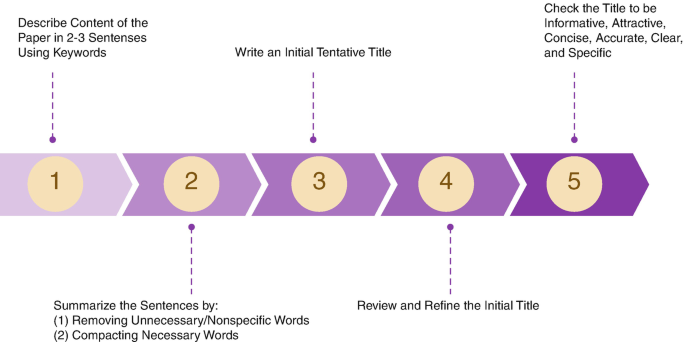Abstract
‘What’s in a name? That which we call a rose by any other name would smell as sweet’ is a famous quote from Shakespeare’s play ‘Romeo and Juliet’. However, in biomedical research, the title or name of the article is without any reservation the most important part of the paper and the most read part in the journal. The title is the face of the research and it should sum up the main notion of the experiment/research in such a way that in the fewest possible words one can summarize the facts of the paper and attract the reader as well. ‘Being concise, precise, and meticulous is the key’ for planning a title [1].
A title should predict the content of a paper, should be interesting, reflect the tone of writing, and contain important keywords so that it can be easily located.
You have full access to this open access chapter, Download chapter PDF
Similar content being viewed by others
1 Why is the Title So Important in Biomedical Research?
‘What’s in a name? That which we call a rose by any other name would smell as sweet’ is a famous quote from Shakespeare’s play ‘Romeo and Juliet’. However, in biomedical research, the title or name of the article is without any reservation the most important part of the paper and the most read part in the journal. The title is the face of the research and it should sum up the main notion of the experiment/research in such a way that in the fewest possible words one can summarize the facts of the paper and attract the reader as well. ‘Being concise, precise, and meticulous is the key’ for planning a title [1].
The title should not be very lengthy and also it should not contain several unnecessary words, e.g., ‘A Study to Investigate the safety and efficacy of Hydroxychloroquine in subjects who are infected with COVID-19 during the pandemic’ contains many extra words and could be easily replaced by ‘Safety and efficacy of Hydroxychloroquine during the COVID-19 pandemic’. Besides this, a title that is too petite or brief would not convey what the paper is all about. For example, ‘COVID depression’ does not provide the necessary information to the readers of the paper.
The title thus has two functions, first to help the scientific sites to index the academic paper, and second, it acts like a billboard or advertisement to sell the paper.
2 What Parameters Help to Formulate a Suitable Research Paper Title?
Time should be spent in planning the title. Editors often reject an article based on its title [2]. Typically, principal investigators and their coinvestigators should select the title accurately so that it captures the central ideal of the research. Devoting time to the title can help writers to relook at the main purpose of the study and also reconsider if ‘they are drifting off on a tangent while writing’. There are many adjectives to describe the title of a medical paper and these include ‘simple, direct, accurate, appropriate, specific, functional, interesting, attractive/appealing, concise/brief, precise/focused, unambiguous, memorable, captivating and informative’ [2,3,4]. The following information is important while designing the title.
-
The aim of the research project.
-
The type of the study.
-
The methodology used in the project.
-
PICOT: population/problem, intervention (test, drug or surgery), control/comparison and time.
3 How to Plan Effective Titles in Academic Research Papers?
Although the title appears on the top of the article, it should be written only after the abstract has been written and finalized. There are five basic steps for writing the title. After doing this exercise, one should jot down two or three options and then choose wisely which is the best for your paper. Titles are typically arranged to form a phrase, but can also be in the form of a question. The grammar should be correct and one should capitalize all the first words. In academic papers, a title is rarely followed by an exclamation mark. Ideally, the ‘title’ should be ‘descriptive, direct, accurate, appropriate, interesting, concise, precise and unique’ [1].
-
Step 1: Write scope of the study and the major hypothesis in a point format.
-
Step 2: Use current nomenclature from the manuscript or keywords and dependent and independent variables.
-
Step 3: Break down the study into the various components of PICOT.
-
Step 4: Frame phrases that give a positive impression and stimulate reader interest.
-
Step 5: Finally organize and then reorganize the title (Fig. 16.1).
4 What Things Should Be Avoided in the Title?
One should avoid the following.
-
Avoid using abbreviations and symbols in the title.
-
Limit the word count to 10–15.
-
Do not include ‘study of’, ‘analysis of’, or a similar assembly of words.
-
Avoid using unfamiliar jargon not used in the text.
-
The title should not be misleading.
-
Amusing titles may be taken less seriously by readers and maybe cited less often [2, 5].
5 What are the Types of Titles for an Academic Paper?
Classically three types of titles have been described in the literature, i.e., descriptive, declarative, or interrogative. The fourth category which is Creative is also called the combined type. The details are given in Fig. 16.2.
5.1 Descriptive or Neutral Title?
This has the vital components of the research paper, i.e., information on the subjects, study design, the interventions used, comparisons/control, and the outcome. It is the PICOT style of a title but does not disclose the observations, results, or conclusions [4, 6]. The descriptive title is based on multiple keywords and provides an opportunity for the reader to decide about the results in an unbiased matter. This type of title is usually preferred in original articles and is also more read and cited as compared to the other types [6, 7]. Examples are given in Table 16.1.
5.2 Declarative Title
The title provides the main results of the study and decreases inquisitiveness and thus should be avoided. A few examples are cited in Table 16.2.
5.3 Interrogative Title
In this, the title ends with a question mark which increases the reads and the downloads. When the title is in the form of a query it dramatizes the subject and the readers become inquisitive. A few examples are cited in Table 16.3.
5.4 Creative Phrase/Combined Type of Title
This title is used for editorials or viewpoints. Sometimes it can be used in original articles but in such cases, there is the clubbing of an informative with a creative phrase. Usually, the informative part is the main and the creative is the minor part of the title. The latter gives a punch. Both can be separated by a colon or hyphen (Table 16.4).
6 What is a Short-running Title?
Many journals will ask for a short running title that is published on the top of each page. The requirements for this, e.g., the word count should be checked with the journal.

7 Conclusions
-
The title provides the most important information which helps in indexing and also attracts readers.
-
The word count for the title should be less than 16.
-
There are four types of title descriptive, declarative, interrogative, and creative. The majority of original articles have a descriptive title.
-
There are five basic steps that you need to follow when designing a title. They start with writing the hypothesis and finish with a phrase that can hold the attention of the reader.
References
Tullu MS. Writing the title and abstract for a research paper: being concise, precise, and meticulous is the key. Saudi J Anaesth. 2019;13(Suppl 1):S12–7.
Bavdekar SB. Formulating the right title for a research article. J Assoc Physicians India. 2016;64:53–6.
Tullu MS, Karande S. Writing a model research paper: a roadmap. J Postgrad Med. 2017;63:143–6.
Dewan P, Gupta P. Writing the title, abstract and introduction: looks matter! Indian Pediatr. 2016;53:235–41.
Sagi I, Yechiam E. Amusing titles in scientific journals and article citation. J Inf Sci. 2008;34:680–7.
Cals JWL, Kotz D. Effective writing and publishing scientific papers, part II: title and abstract. J Clin Epidemiol. 2013;66:585.
Jamali HR, Nikzad M. Article title type and its relation with the number of downloads and citations. Scientometrics. 2011;88:653–61.
Jax T, Stirban A, Terjung A, Esmaeili H, Berk A, Thiemann S, Chilton R, von Eynatten M, Marx N. A randomised, active-and placebo-controlled, three-period crossover trial to investigate short-term effects of the dipeptidyl peptidase-4 inhibitor linagliptin on macro-and microvascular endothelial function in type 2 diabetes. Cardiovasc Diabetol. 2017 Dec;16(1):1–6.
Kelly AS, Auerbach P, Barrientos-Perez M, Gies I, Hale PM, Marcus C, Mastrandrea LD, Prabhu N, Arslanian S. A randomized, controlled trial of liraglutide for adolescents with obesity. N Engl J Med. 2020 May 28;382(22):2117–28.
Xia S, Duan K, Zhang Y, Zhao D, Zhang H, Xie Z, Li X, Peng C, Zhang Y, Zhang W, Yang Y. Effect of an inactivated vaccine against SARS-CoV-2 on safety and immunogenicity outcomes: interim analysis of 2 randomized clinical trials. JAMA. 2020 Sep 8;324(10):951–60.
Jackson JB, MacDonald KL, Cadwell J, Sullivan C, Kline WE, Hanson M, Sannerud KJ, Stramer SL, Fildes NJ, Kwok SY, Sninsky JJ. Absence of HIV infection in blood donors with indeterminate Western blot tests for antibody to HIV-1. N Engl J Med. 1990 Jan 25;322(4):217–22.
Seeman E, Hopper JL, Bach LA, Cooper ME, Parkinson E, McKay J, Jerums G. Reduced bone mass in daughters of women with osteoporosis: N Engl J Med.1989;320/9(554–558). Maturitas. 1989 Sep 1;11(3):244.
Weber R, Bryan RT, Owen RL, Wilcox CM, Gorelkin L, Visvesvara GS. Improved light-microscopical detection of microsporidia spores in stool and duodenal aspirates. The Enteric Opportunistic Infections Working Group. N Engl J Med. 1992;326:161–6.
Paul S, Ridge JA, Quan SH, Elin RS. Ann Surg. 1990;211:67–71.
Clavien PA. Hepatic vein embolization for safer liver surgery. Ann Surg. 2020;272:206–9.
Rosenberger PB. Dyslexia—is it a disease? N Engl J Med. 1992;326:192–3.
Winthrop KL, Mariette X. To immunosuppress: whom, when and how? That is the question with COVID-19. Ann Rheum Dis. 2020;79:1129–31.
Issaka RB. Good for us all. JAMA. 2020;324(6):556–7. https://doi.org/10.1001/jama.2020.12630.
Kay R. Old wine in new bottle. Hong Kong Med J. 2007;13(1):4.
Tandon V, Botha JF, Banks J, Pontin AR, Pascoe MD, Kahn D. A tale of two kidneys—how long can a kidney transplant wait? Clin Transpl. 2000;14:189–92. https://doi.org/10.1034/j.1399-0012.2000.140302.
Grant Stewart: pain, panic, and panting—the reality of “shortness of breath”. BMJ. 2020.
Aronson. When I use a word … clowns. The BMJ 2020 blog. https://blogs.bmj.com/bmj/2020/08/14/jeffrey-aronson-when-i-use-a-word-clowns/.
Author information
Authors and Affiliations
Rights and permissions
Open Access This chapter is licensed under the terms of the Creative Commons Attribution 4.0 International License (http://creativecommons.org/licenses/by/4.0/), which permits use, sharing, adaptation, distribution and reproduction in any medium or format, as long as you give appropriate credit to the original author(s) and the source, provide a link to the Creative Commons license and indicate if changes were made.
The images or other third party material in this chapter are included in the chapter's Creative Commons license, unless indicated otherwise in a credit line to the material. If material is not included in the chapter's Creative Commons license and your intended use is not permitted by statutory regulation or exceeds the permitted use, you will need to obtain permission directly from the copyright holder.
Copyright information
© 2022 The Author(s)
About this chapter
Cite this chapter
Nundy, S., Kakar, A., Bhutta, Z.A. (2022). How to Choose a Title?. In: How to Practice Academic Medicine and Publish from Developing Countries?. Springer, Singapore. https://doi.org/10.1007/978-981-16-5248-6_16
Download citation
DOI: https://doi.org/10.1007/978-981-16-5248-6_16
Published:
Publisher Name: Springer, Singapore
Print ISBN: 978-981-16-5247-9
Online ISBN: 978-981-16-5248-6
eBook Packages: MedicineMedicine (R0)






